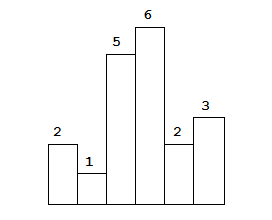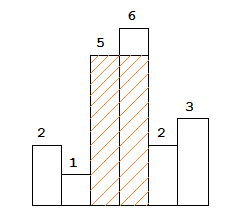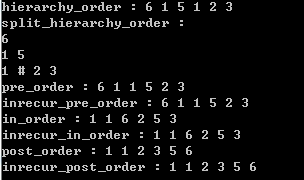1.Valid Parentheses
Given a string containing just the characters ‘(‘, ‘)’, ‘{‘, ‘}’, ‘[’ and ‘]’, determine if the input string is valid.
The brackets must close in the correct order, “()” and “()[]{}” are all valid but “(]” and “([)]” are not.
Solution:
时间复杂度O(n),空间复杂度O(n)
bool isValid(string const& s)
{
string left = "([{";
string right = ")]}";
stack<char> stk;
for (int i = 0; i < s.size(); i++)
{
char c = s[i];
if(left.find(c) != string::npos)
stk.push(c);
else
{
if(stk.empty() || stk.top() != left[right.find(c)])
return false;
else
stk.pop();
}
}
return stk.empty();
}2.Longest Valid Parentheses
Given a string containing just the characters ‘(’ and ‘)’, find the length of the longest valid (well-formed) parentheses substring.
For “(()”, the longest valid parentheses substring is “()”, which has length = 2.
Another example is “)()())”, where the longest valid parentheses substring is “()()”, which has length = 4.
Solution:
时间复杂度O(n),空间复杂度O(n)
int longestValidPaarentheses(string s)
{
int max_len = 0;
int last = -1; //the position of the last ')'
stack<int> lefts; //keep track of the positions of non-matching '('s
for (int i = 0; i < s.size(); i++)
{
if(s[i] == '(')
lefts.push(i);
else
{
if(lefts.empty())
last = i; //no matching left
else
{
//find a matching pair
lefts.pop();
if(lefts.empty())
max_len = max(max_len,i-last);
else
max_len = max(max_len,i-lefts.top());
}
}
}
return max_len;
}3. Largest Rectangle in Histogram
Given n non-negative integers representing the histogram’s bar height where the width of each bar is 1, find the area of largest rectangle in the histogram.

Above is a histogram where width of each bar is 1, given height = [2,1,5,6,2,3].

The largest rectangle is shown in the shaded area, which has area = 10 unit.
For example,
Given heights = [2,1,5,6,2,3],
return 10.
分析:
如上图,从左向右处理直方,当i=4时,小于当前栈顶(即直方3),对于直方3,无论后面还是前面的直方,都不能得到比目前栈顶元素更高的高度了,处理掉直方3(计算从直方3到直方4之间的举行的面积,然后从栈里弹出);对于直方2也是如此;直到碰到比直方4更矮的直方1.
这就意味着,可以维护一个递增的栈,每次比较栈顶与当前元素。如果当前元素大于栈顶元素,则入栈,直至栈顶元素小于当前元素。结尾时入栈元素0,重复合并一次。
Solution:
时间复杂度O(n),空间复杂度O(n)
int largestRectangleArea(vector<int> &height)
{
stack<int> s;
height.push_back(0); //结尾入栈元素为0
int result = 0;
int i = 0;
while(i < height.size())
{
if(s.empty() || height[i] > height[s.top()])
s.push(i++);
else
{
int tmp = s.top();
s.pop();
result = max(result,height[tmp]*(s.empty() ? i : i-s.top()-1));
}
}
return result;
}下面是二叉树非递归遍历,包括分层层次遍历,非递归先序、中序、后序遍历。先放一张图,是结果截图。
由于主要用到的是栈和队列,故放在本专题
4.层次遍历分层打印
层次遍历用到了队列这一数据结构,分层打印则需要记录当前层和下一层需要打印的个数。
void split_hierarchy_order(Node* root)
{
queue<Node*> q;
Node* p;
q.push(root);
int cur_hierarchry_count = 1;
int next_hierarchy_count = 0;
while(!q.empty())
{
if(cur_hierarchry_count > 0)
{
p = q.front();
q.pop();
if(p != NULL)
cout << p->val << " ";
else
cout << "#" << " ";
cur_hierarchry_count--;
if(p != NULL && (p->left != NULL || p->right != NULL)) //这里运行了C++的判断机制:一旦p != NULL不成立,由于后面的 && 操作符就不继续判断了,从而p->left不会报错
{
q.push(p->left);
next_hierarchy_count++;
q.push(p->right);
next_hierarchy_count++;
}
}
else
{
cout << endl;
cur_hierarchry_count = next_hierarchy_count;
next_hierarchy_count = 0;
}
}
}
下面的先序、中序、后序遍历的非递归遍历都需要用到栈这一数据结构
5.非递归先序遍历
void inrecur_pre_order(Node* root)
{
stack<Node*> s;
Node* p = root;
while (!s.empty() || p != NULL)
{
while(p != NULL)
{
cout << p->val << " ";
s.push(p);
p = p->left;
}
if (!s.empty())
{
p = s.top();
p = p->right;
s.pop();
}
}
}6.非递归中序遍历
非递归中序遍历与先序遍历思路基本差不多,对于何时打印节点的值稍微考虑一下就行了。
void inrecur_in_order(Node* root)
{
stack<Node*> s;
Node* p = root;
while (!s.empty() || p != NULL)
{
while (p != NULL)
{
s.push(p);
p = p->left;
}
if (!s.empty())
{
p = s.top();
cout << p->val << " ";
s.pop();
p = p->right;
}
}
}7.非递归后序遍历
非递归后续遍历应该是非递归遍历中最难的了,为了方便理解思路。我们需要在数据结构做些改动。
struct Node{
int val;
Node* left;
Node* right;
bool isFirst; //用于记录节点是否是第一次被访问
Node(int value,Node* l = NULL,Node* r = NULL,bool isF = false):val(value),left(l),right(r),isFirst(isF){};
};根据非递归后续遍历的任务,我们可以理解为在节点第二次被访问时进行输出。
void inrecur_post_order(Node* root)
{
stack<Node*> s;
Node* p = root;
while (p != NULL || !s.empty())
{
while (p != NULL)
{
s.push(p);
p->isFirst = true;
p = p->left;
}
if (!s.empty())
{
p = s.top();
s.pop();
if (p->isFirst == true) //第一次出现在栈顶
{
s.push(p);
p->isFirst = false;
p = p->right;
}
else //第二次出现在栈顶
{
cout << p->val << " ";
p = NULL; //很重要
}
}
}
}
























 371
371

 被折叠的 条评论
为什么被折叠?
被折叠的 条评论
为什么被折叠?








